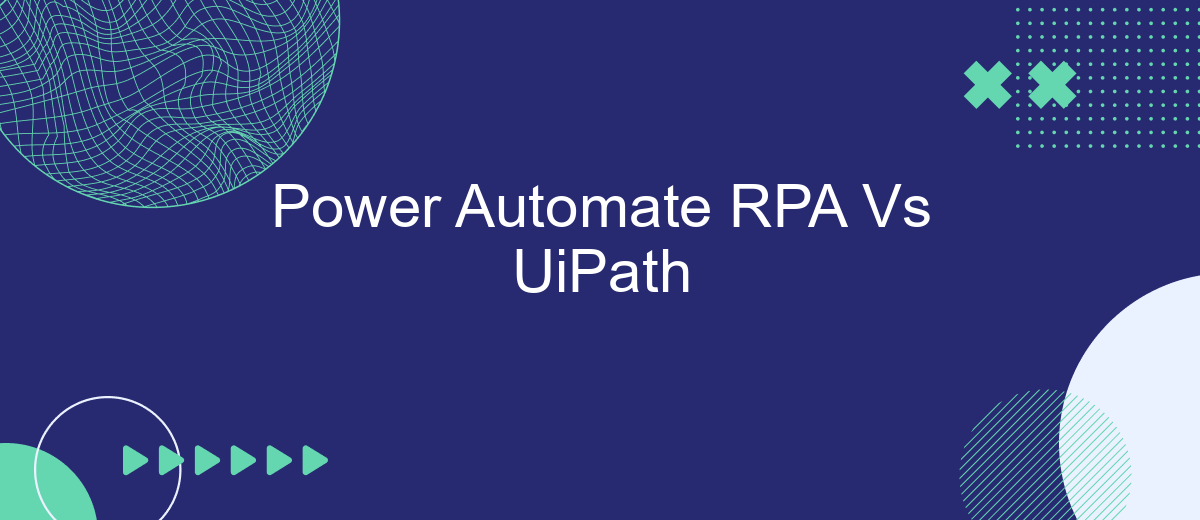In the rapidly evolving landscape of automation, choosing the right Robotic Process Automation (RPA) tool is crucial for optimizing business processes. This article compares two leading RPA platforms: Microsoft's Power Automate and UiPath. By examining their features, capabilities, and use cases, we aim to help you determine which solution best fits your organization's needs and drives efficiency in your workflow.
Introduction
In today's fast-paced digital world, businesses are constantly seeking ways to automate repetitive tasks and streamline workflows. Robotic Process Automation (RPA) has emerged as a powerful solution to achieve these goals. Two prominent players in the RPA market are Microsoft Power Automate and UiPath. Both platforms offer robust automation capabilities, but they cater to different needs and use cases.
- Power Automate: Seamlessly integrates with Microsoft 365 and other Microsoft services.
- UiPath: Known for its extensive range of automation tools and scalability.
- SaveMyLeads: Facilitates easy integration with various platforms, enhancing automation processes.
This article aims to compare Power Automate and UiPath, highlighting their strengths and weaknesses. By understanding the unique features and benefits of each platform, businesses can make informed decisions on which RPA tool best fits their specific requirements. Whether you're looking to automate simple tasks or complex processes, this comparison will provide valuable insights into the capabilities of Power Automate and UiPath.
Capabilities and Features

Power Automate RPA and UiPath offer robust capabilities and features designed to streamline business processes through automation. Power Automate RPA, part of Microsoft's Power Platform, enables users to automate workflows across various applications and services. It integrates seamlessly with Microsoft 365, Dynamics 365, and other third-party services, providing a comprehensive solution for automating repetitive tasks. With its intuitive drag-and-drop interface, even users with minimal coding experience can create powerful automation workflows.
UiPath, on the other hand, is a leading RPA tool known for its advanced automation capabilities. It supports a wide range of applications and systems, offering features like AI integration, process mining, and advanced analytics. UiPath's extensive library of pre-built automation components accelerates the development process, making it easier for businesses to deploy automation solutions rapidly. Additionally, services like SaveMyLeads can enhance both platforms by facilitating the integration of various applications, ensuring seamless data flow and improving overall efficiency.
Pricing and Licensing

When comparing the pricing and licensing of Power Automate RPA and UiPath, it's essential to consider both cost structures and the flexibility they offer. Both platforms provide a range of pricing options to accommodate various business needs, from small enterprises to large corporations.
- Power Automate RPA: Power Automate offers a per-user plan starting at per user/month and a per-flow plan at 0 per flow/month. The pricing can vary depending on the complexity and number of automated processes.
- UiPath: UiPath provides a more comprehensive pricing model, including a Community Edition (free for individual use), an Enterprise Edition with custom pricing, and a Cloud-based service starting at 0 per user/month.
Both platforms also offer additional services and integrations to enhance their capabilities. For instance, services like SaveMyLeads can be utilized to streamline data integration processes, making it easier to connect various applications and automate workflows efficiently. Choosing the right RPA tool will depend on your specific needs, budget, and the level of support required.
Use Cases and Industry Applications

Power Automate RPA and UiPath are widely used in various industries to streamline processes and enhance efficiency. Both platforms offer robust solutions for automating repetitive tasks, enabling businesses to focus on more strategic activities.
Power Automate RPA is often utilized in sectors such as finance, healthcare, and retail for automating data entry, invoice processing, and customer service operations. UiPath, on the other hand, is favored in industries like manufacturing, logistics, and telecommunications for its advanced capabilities in robotic process automation and AI integration.
- Finance: Automating account reconciliations and transaction processing.
- Healthcare: Streamlining patient data management and appointment scheduling.
- Retail: Enhancing inventory management and order processing.
- Manufacturing: Optimizing supply chain operations and quality control.
- Logistics: Improving shipment tracking and warehouse management.
Both platforms also support integration with various third-party services to further extend their capabilities. For instance, SaveMyLeads can be used to automate lead management and data synchronization across different CRM systems, ensuring seamless workflow automation and improved data accuracy.
Conclusion
In conclusion, both Power Automate RPA and UiPath offer robust solutions for automating business processes, each with its own unique strengths. Power Automate RPA excels in its seamless integration with Microsoft products and its user-friendly interface, making it an excellent choice for organizations already invested in the Microsoft ecosystem. On the other hand, UiPath stands out with its advanced features and extensive capabilities, making it suitable for complex automation tasks and large-scale deployments.
When considering which tool to adopt, it's essential to evaluate your organization's specific needs, existing infrastructure, and future automation goals. Additionally, integrating third-party services like SaveMyLeads can further enhance automation workflows by streamlining data transfers and improving overall efficiency. Ultimately, the choice between Power Automate RPA and UiPath should be guided by the unique requirements and strategic objectives of your business, ensuring that the selected platform aligns with your long-term automation strategy.
- Automate the work with leads from the Facebook advertising account
- Empower with integrations and instant transfer of leads
- Don't spend money on developers or integrators
- Save time by automating routine tasks
FAQ
What are the main differences between Power Automate RPA and UiPath?
Which tool is more suitable for small to medium-sized businesses?
Can both tools handle unattended automation?
How do these tools integrate with other software and services?
Which tool offers better support and community resources?
Would you like your employees to receive real-time data on new Facebook leads, and automatically send a welcome email or SMS to users who have responded to your social media ad? All this and more can be implemented using the SaveMyLeads system. Connect the necessary services to your Facebook advertising account and automate data transfer and routine work. Let your employees focus on what really matters, rather than wasting time manually transferring data or sending out template emails.

